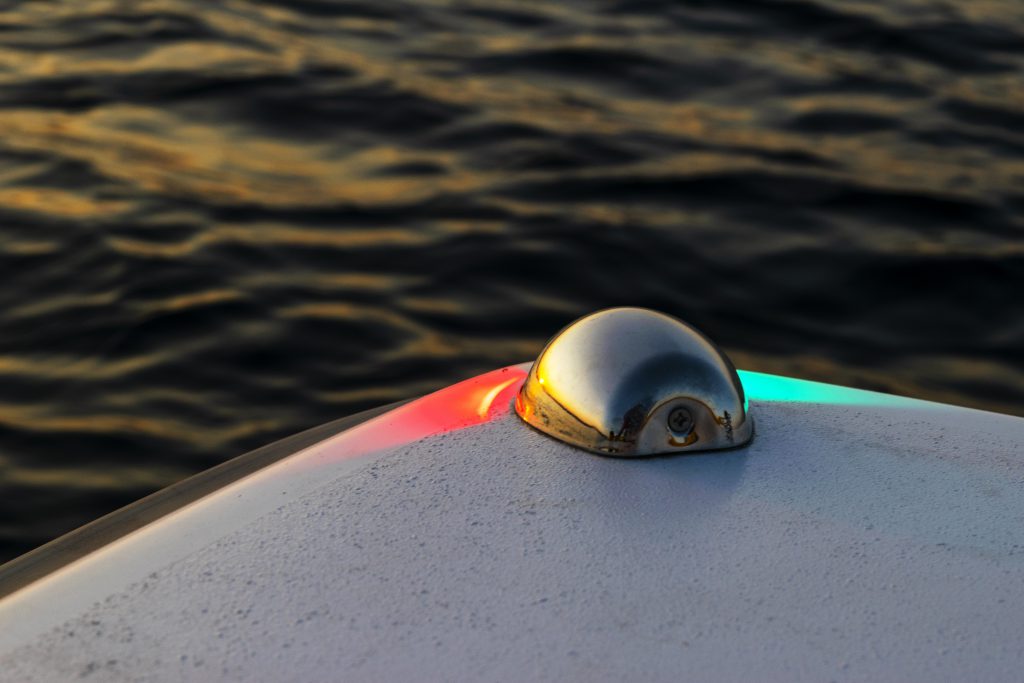Night Time Safety at Sea
May 1st, 2020 by inavx

by B.J. Porter (Contributing Editor)
Sailing offshore at night connects you to the sea in your surroundings in a way that’s hard to explain. The universe contracts to just the boat as visibility drops, and you rely on your other senses. The slap of the waves, the whisper of the wind, or the gentle huff of unseen dolphins breathing off your quarter bring you into the moment. Yet the universe also explodes down on you with the breathtaking beauty of more stars than you can see anywhere on earth.
But doing everything in the dark – from sail changes to harbor approaches – adds a level of difficulty. Without taking a little care, difficulty can change to danger.
So how can you make it safer?
Personal Safety
We’ve got a few ironclad rules for personal and boat safety we follow when sailing at night. If someone goes overboard offshore in the dark, the odds of recovery are low. If no one knows they’ve gone over the odds are near zero. So what do we always do?
- PFDs are mandatory above decks. We do this anyway offshore, even during the day, because if something goes wrong it happens fast. You don’t want to forget your PFD in the rush to sort it. This goes double for night time.
- Tethers are also mandatory in the dark. If you are out of the companionway, you clip to something. Even sitting in our center cockpit, we do this. Get two legged tethers, so when moving on the deck you can always keep one point attached to the boat.
- Nobody every leaves the cockpit at night without a spotter. If something needs correction outside the cockpit, the watch stander must wake someone up to watch them go out. We’re never going up to relieve a watch to find the decks empty. For solo sailors, this is impossible. But if you have crew, use it.
- Install and use jack lines. We put these on the boat before any overnight passages just in case. We avoid going on the deck at night if we can, but if you have to, you want jack lines to guarantee a solid place to clip on.
- Dress for the occasion. Offshore it gets cold, sometimes even in the tropics. A cold watch is not a sharp watch. So gear up well and don’t tough out the cold. And if you have to step outside the cockpit, you don’t want to get wet.
Safety Strategies
Non-sailors ask us what we do at night. “Do you stop? Do you sleep?” We’re cruisers, not racers, but we don’t stop either.

Someone is always awake and alert in the cockpit. We plan for safety before the sun goes down every day. We’re fortunate on our boat, because we can set, reef, and douse all the sails but the staysail from the cockpit, and the staysail is optional. It gives us flexibility when things change.
Before the evening we review the course and expected weather with everyone. We’re looking for changes in the wind strength and direction, and deterioration in the weather. If we expect changes, we’ll make sure each watch knows what to expect and when, what to look for, and what to do when it happens. These discussions often happen over dinner, which we eat before sunset. Cooking and eating is easier with light, and we still have time to make changes before dark.
Often, we’ll reduce sail before dark with an expected increase in wind by taking down the staysail or even reefing the main and jib. We’re not racing, and we’d rather lose a knot or two of speed overnight than have to go forward to wrestle a sail down in a blow. Keeping crew in the cockpit at night is the major aim.
Night Sailing Near Land
Sailing after dark near the coast has more dangers, because there’re more things to hit. Everything from shoals to ships to unlit marks. Most hazards are marked, but a few are not. But worse, at night things look different. It’s hard to tell the relative position of lights in the distance, land masses look ominous and deceiving since you can’t tell how far off they are if they aren’t well lit or the moon isn’t bright.

We avoid approaching strange harbors at night; familiar ones are challenging enough. We’ll heave-to and wait for light if we’re at all unsure. If you’re sailing near land at night, there are a few things to keep in mind.
- Watch the timings of the lights. Your chart will have intervals spelled out, so count seconds and match patterns and colors to identify marks.
- Plot a conservative course. No cutting corners or marks, and plot away from the edges of channels.
- Keep your head out of the boat as much as you can and protect your night vision, though someone should be on radar/AIS watch if you have it.
- Know your navigation lights, so you can tell which way ships and boats are moving and what they are. Big ships moving in the distance look slow, so knowing where they are pointing is important.
- Keep a powerful flashlight on hand to light up marks to confirm your position. Most marks have reflective numbers on them, visible from a long way away. Even an unlit mark may have these, so wave that focused light where you think the mark is and watch for the numbers to flash.
- Think about a second person on watch if it’s crowded or narrow to help spot marks and other vessels.
At the end of the day, well night. Night time safety is no different from all vessel safety. Plan accordingly, be deliberate and diligent, and work as a team.
- Posted in Blog, Boating Tips, Cruising, Fishing, iNavX, Navigation, Sailing, Sailing Tips
- No Comments
Comments are closed.

